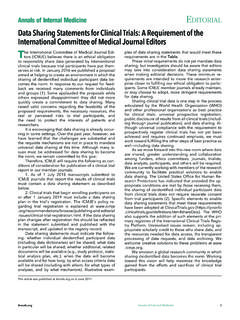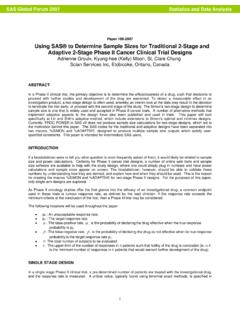Transcription of Not All Clinical Trials Are Created Equal – …
1 Not All Clinical Trials Are Created Equal understanding the Different PhasesThis chapter will help you understand the differences between the various Clinical trial phases and how these differences impact your responsibilities as a principal 1. Typical drug development schemaIND, investigational new drug application = request for authorization to test a new compound in humans from the US Food and Drug Administration (FDA); NDA, new drug application = request for marketing approval from the Clinical development process for pharmaceutical agents is designed to provide the maximum in-formation about a new investigational compound or intervention with the least risk to study subjects. Each Clinical trial is performed to answer a specific research question, with the overarching purpose of improving patient origin of a new drug used to be serendipitous, with a random discovery that a natural compound had beneficial effects.
2 As our knowledge about disease pathophysiology has expanded, the drug dis-covery process has become more targeted. However, most compounds that undergo identification, synthesis, characterization, and screening fail to show activity. For those few compounds that do demonstrate activity in vitro, preclinical (animal) studies are conducted to confirm the compound that showed promise actually has a beneficial effect on a living being. Preclinical studies also determine potential toxic effects at various doses and help to answer questions about drug absorption, metabo-lism, and elimination. Many compounds do not progress beyond the preclinical stage because they either fail to show any therapeutic activity or prove to be too studies in humans begin after preclinical work has been completed. In the United States, before any studies in humans can begin, the drug sponsor must submit an investigational new drug (IND) application to the US Food and Drug Administration (FDA) for review.
3 Because the FDA man-dates that all drugs be approved before they can be transported or distributed across state lines, the IND is the formal process by which the study sponsor technically obtains exemption from this law PreclinicalResearchLaboratoryTestingAnim alStudiesIND SubmittedClinicalTrialsClinicalResearchP ostmarketingSurveillanceRegulatory ApprovalNDA SubmittedShort-termPhase 1 Phase 2a & 2bPhase 3a & 3bPhase 4 Long-termfrom the FDA. The purpose of the IND process is to ensure that humans will not be subjected to un-reasonable Trials are conducted in four phases also to ensure the safety of the study subjects. As develop-ment progresses through the phases (1 4), more patients are included and different questions are an-swered. Figure 1 provides an overview of the generic development process. Oftentimes, several studies of each phase are conducted, and the timing of the studies frequently overlaps (ie, Phase 3 studies are initiated before all of the Phase 2 studies are complete).
4 Further discussion of each phase is presented Trial PhasesPhase 1 Phase 1 Trials represent the first time an experimental drug/treatment is tested in humans. The pur-pose of these Trials is to define the treatment s safety, determine a safe dosage range, and explore the drug s metabolism, and pharmacokinetic and pharmacodynamic profile. Phase 1 studies are generally shorter in duration than subsequent phases. These Trials are often conducted in the in-patient setting, so that effects can be carefully monitored. The tested range of doses will usually be a smaller percent-age relative to body weight of the dose that caused harm in animal studies. During Phase 1, sufficient information must be obtained to allow the design of well-controlled Phase 2 only a small group of subjects (20 80) is employed, and they are usually free of disease ( healthy ), so as not to confound the results. Patients with seriously impaired organ function (ie, kid-ney, liver, lung) may have less tolerance to the investigational compound, making it difficult to assess toxicity and increasing the risk of unacceptable side effects.
5 For terminal conditions, such as cancer, however, patients with advanced disease may be included because they may not have other options. But, it has been estimated that only about 5% of participants in oncology Phase 1 Trials clinically ben-efit from the study 1 studies are often designed such that small cohorts (3 6 patients) are administered different predefined dose levels. Doses are initially very low and based on the safety data from the preclinical studies. Different types of Phase 1 studies are conducted. One common initial study is the Single As-cending Dose study (SAD) where subjects are given a single dose of the drug for a set period of time. If no significant adverse effects are observed and the pharmacokinetic data are within predicted safe values, the dose is escalated, and a new cohort of subjects is then given the higher dose. This proce-dure is continued until a predetermined pharmacokinetic safety threshold is reached or intolerable side effects appear.
6 This threshold is the maximum tolerated dose (MTD).The Multiple Ascending Dose study (MAD) functions to define the pharmacokinetic and pharmaco-dynamic parameters of multiple doses of the investigational compound and often follows single dose Phase I studies. In these studies, multiple low doses of the drug are administered, and analyses are performed at various time points to understand how the drug is processed within the body. The dose is then subsequently escalated in another cohort of subjects up to a predetermined analysis of the effect of food on the pharmacokinetic profile of the investigational compound is another type of Phase 1 study. These studies are usually performed using a crossover design: subjects are given the compound at identical doses at 2 time points, when fasting and then after being fed a specified, often high-fat, 2 Phase 2 Trials are conducted in a larger group of subjects (100 300), who have a particular disease or condition, to determine the treatment s efficacy and further evaluate safety.
7 Phase 2 studies are usually conducted at a limited number of sites. These studies are sometimes divided into Phase 2A and Phase 2B Trials , where Phase 2A Trials are specifically designed to assess dosing, and Phase 2B is specifically designed to determine subjects enrolled in Phase 2 Trials have the target disease that the investigational compound is intended to treat, a relatively small and narrowly defined patient population is usually tested. The number of patients in Phase 2 Trials is greater than that in Phase 1 studies because more patients are necessary to determine statistical significance, and because safety data in Phase 1 studies support the exposure of more subjects to the study doses and schedules are usually included in these Trials . Most commonly, these are con-trolled studies where subjects are randomly assigned to receive multiple doses of the investigational compound or a comparator ( control ), which is usually placebo.
8 For some disease states, an active control population might be used depending on the standard of care. An example would be psoriatic arthritis, where the effects of a biologic intervention plus a disease-modifying antirheumatic drug (DMARD) is tested against a DMARD-only group, where the standard of care ( active control ) would be the DMARD. The end points are most often defined as the observed effects of treatment on symp-toms or on some surrogate for what might be a more important Clinical 3In Phase 3 Trials , the experimental drug/treatment is tested on a large group of subjects (1000 3000) with disease to confirm the treatment s efficacy, monitor side effects, compare it to commonly used therapies, and collect information that will allow the experimental treatment to be used safely. The study population is generally broader than the Phase 2 studies. Phase 3 Trials are conducted at a large number of sites often across the country or in multiple countries.
9 Sometimes these studies are differ-entiated into Phase 3A and Phase 3B Trials , where 3A Trials are performed before marketing approval, and 3B Trials are supplemental to other Trials (ie, longer-term information) or provide additional in-formation (ie, effects on quality of life). Approval agencies (US Food and Drug Administration [FDA], European Medicines Agency [EMEA], Japan s Pharmaceuticals and Medical Devices Agency [PMDA]) prefer to have the results of two Phase 3 Clinical Trials before making a decision on the approval of an investigational compound. The data from Phase 3 Trials are also used to expand the label of a mar-keted drug; for example in the case of a new indication or additional age group for which the product can be studies are randomized and controlled Trials . Subjects are randomly assigned to receive either the investigational compound (generally fewer doses than Phase 2) or a comparator ( control ), which can be either placebo or the standard of care ( active control ).
10 In general, fewer types of doses are tested in phase 3 studies as a consequence of the results obtained in phase 2. A large number of pa-tients is sometimes required to detect a statistical difference between 4 (postmarketing)After a drug has been approved by the regulatory agencies, research on the effects of the product con-tinues. The term postmarketing surveillance is frequently used to describe studies conducted after a product is marketed. These studies are primarily observational or nonexperimental in nature, but well-controlled Phase 4 studies can also be purpose of postmarketing studies (both observational and controlled) is to determine additional information such as the treatment s long-term risks, additional benefits, and optimal schedule, or to test the product in a broader population, such as children. Regulatory authorities may mandate these studies, or the sponsoring company may undertake them for competitive reasons or to test for inter-actions with other drugs in certain population groups, such as pregnant women, who are unlikely to subject themselves to Clinical Trials or to be a population studied in Clinical Phases OverviewPhase 1 Phase 2 Phase 3 Phase 4No.







